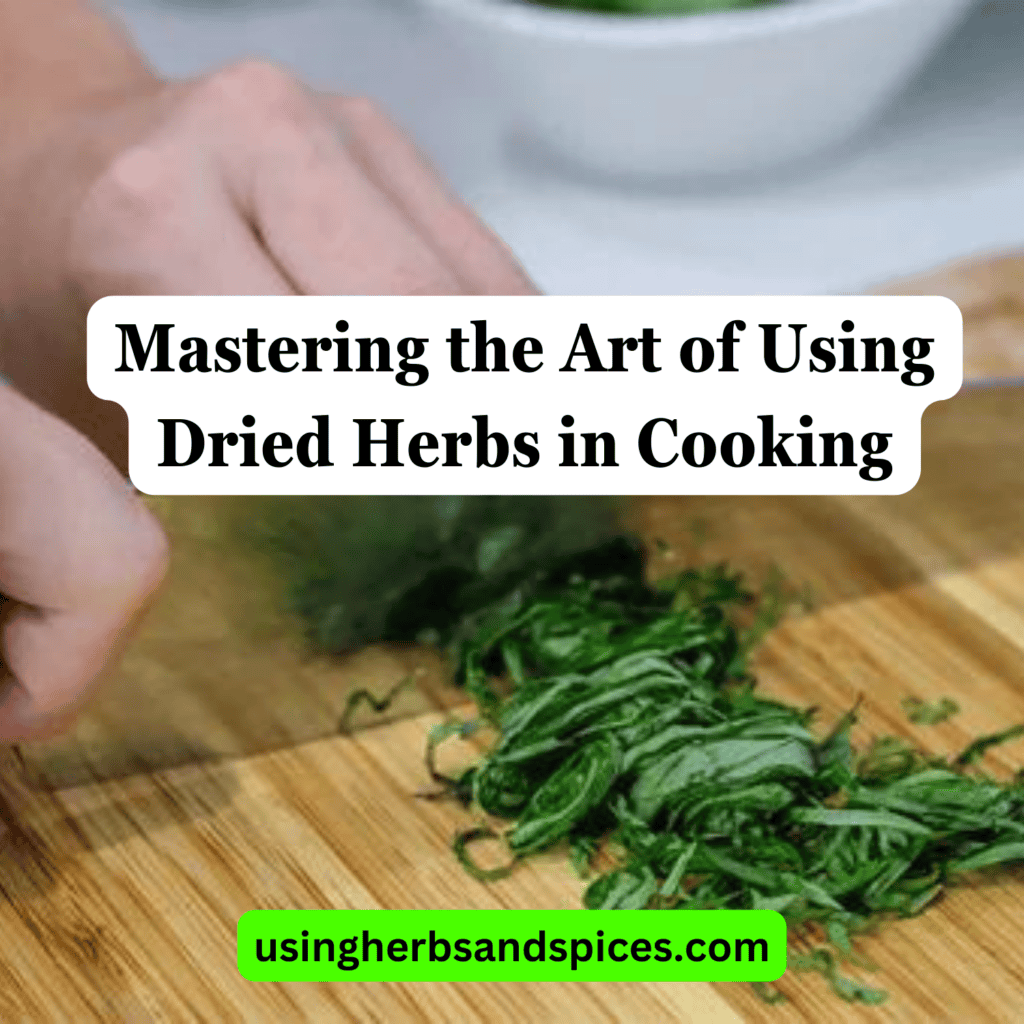Imagine you’re a painter, but instead of colors, you have dried herbs at your disposal to create a culinary masterpiece. You’ve probably heard that dried herbs can pack a more concentrated flavor than their fresh counterparts, a pivotal detail in the canvas of cooking. Mastering their use isn’t just about sprinkling them into your dish; it’s about understanding when and how to incorporate these potent flavors to transform your meals. But how do you guarantee you’re not overpowering your dish or wasting their potential? Let’s explore the art of using dried herbs effectively, revealing secrets to elevate your cooking to the next level.

Key Takeaways
- Use one-third the amount of dried herbs compared to fresh for balanced flavoring.
- Store dried herbs in a cool, dark place in airtight containers to preserve potency.
- Add dried herbs at the start of cooking for dishes that simmer to deepen flavors.
- Crush dried herbs before adding to dishes to enhance their flavor profiles.
- Experiment with homemade spice blends and tea mixes for personalized culinary creations.
Understanding Fresh Vs Dried Herbs
When comparing fresh and dried herbs, it’s important to recognize that each brings its own unique flavors and uses to your cooking. You’re not just choosing between fresh and dried; you’re embracing an array of herb drying methods and managing the seasonal waves of fresh herb availability. This journey enriches your culinary creations, making you part of a community that values depth, tradition, and innovation in the kitchen.
Herb drying methods, such as air drying, dehydrating, or using a low oven, carefully preserve the essence of your favorite herbs. This process makes sure that you can enjoy basil, thyme, rosemary, and more, regardless of the season. It’s a way of capturing the vibrant essence of summer gardens to relish during the colder months.
On the other hand, the fresh herb availability ebbs and flows with the seasons, offering a dynamic palette of flavors. Fresh herbs often bring a brighter, more immediate burst of flavor to dishes, embodying the very essence of spring and summer.
Understanding these differences isn’t just about technique; it’s about feeling connected to a broader culinary tradition. It’s about knowing you have the tools and knowledge to bring out the best in your ingredients, whether they’re fresh from the garden or carefully preserved for year-round enjoyment.
The Flavor Dynamics Explained
Understanding the flavor dynamics between fresh and dried herbs will further enrich your culinary practices, offering insights into how each can uniquely influence your dishes. Dried herbs, concentrated in flavor due to the removal of moisture, pack a powerful punch. This intensity means you’ll often use less compared to their fresh counterparts, especially when mastering herb blending techniques.
When you immerse yourself in these techniques, you’ll discover how to layer flavors for depth and complexity. Dried herbs blend beautifully, their robust profiles standing up against long cooking times, making them ideal for simmered sauces and stews. They’re a confirmation of the power of patience, slowly releasing their essence into your creations.
Seasonal flavor impacts also come into play. During colder months, when fresh herbs might be scarce, dried herbs step up, offering warmth and richness to comfort foods. Conversely, in the bountiful summer, they can add an earthy counterpoint to the bright, fresh flavors of the season.
Calculating Dried Herbs Measurements
To accurately incorporate dried herbs into your dishes, you’ll need to master the art of measurement conversion. Understanding how to translate the importance of dried herbs versus fresh is vital in achieving the desired flavor without overpowering your meal. This journey isn’t just about tossing in a pinch here and there; it’s about precision, balance, and the warmth of a meal that feels like home.
To make this process easier, keep these points in mind:
- Use measuring tools: Precision is key, so a set of measuring spoons is essential.
- Conversion factors: Generally, use one-third the amount of dried herbs to fresh. This simple ratio will save your dishes from becoming flavor bombs.
- Crush them: Releasing the flavors of dried herbs can be achieved by lightly crushing them between your fingers before adding them to your dish.
- Store properly: Keep your dried herbs in a cool, dark place to maintain their potency.
- Experiment: Don’t be afraid to adjust quantities based on your taste preferences and the age of your herbs.
Embracing these guidelines will transform your cooking, ensuring every dish is imbued with the perfect essence of your favorite herbs.
Optimal Times to Add Dried Herbs
Having grasped how to measure dried herbs accurately, it’s equally important to know the best times to add them to your dishes for maximum flavor. Understanding the ideal moment for herb addition is not just about taste—it’s about welcoming your herbs into the cooking process at a time when they can truly shine, guaranteeing they impart their full, rich essence into your culinary creations.
Herb rehydration plays a critical role here. Dried herbs need time to rehydrate and release their flavors. Generally, they’re best added at the beginning of the cooking process, especially in dishes that cook for longer periods. This allows the herbs to slowly infuse your dish with their essence, melding seamlessly with other ingredients.
Seasonal considerations also influence the timing of adding dried herbs. In colder months, hearty stews and soups benefit from early herb introduction, enhancing the deep, comforting flavors these dishes are beloved for.
| Dish Type | Ideal Addition Time |
|---|---|
| Soups & Stews | Early in cooking |
| Sauces | Midway through cooking |
| Baked Goods | Mix with dry ingredients |
| Quick Sauté Dishes | Last few minutes |
Embracing these guidelines ensures every pinch of dried herb you add doesn’t just contribute flavor but becomes an integral part of your dish’s soul.
Preserving the Potency of Dried Herbs
Maintaining the freshness and potency of your dried herbs is crucial for guaranteeing they deliver the most vibrant flavors to your dishes. Proper storage conditions and careful herb selection play pivotal roles in preserving their quality and making sure they remain a cherished part of your culinary toolkit.
Here’s how you can keep your dried herbs at their best:
- Store in a cool, dark place: Exposure to heat and light can degrade the quality of dried herbs over time. A pantry or cabinet away from the stove or any direct sunlight is ideal.
- Use airtight containers: Oxygen can also diminish the potency of dried herbs. Sealing them in airtight containers helps retain their flavor and aroma.
- Label and date: Keeping track of when you stored your herbs can help you use them when they’re most potent. Herbs generally keep well for about a year.
- Avoid humidity: Moisture can lead to mold. Ensure your storage area is dry to prevent spoiling.
- Be selective: Opt for high-quality herbs from reputable sources to make certain you’re starting with the best possible flavor profile.
Mistakes to Avoid With Dried Herbs
When using dried herbs, it’s essential to avoid certain common mistakes that can greatly diminish their contribution to your dishes.
One common pitfall is improper herb storage locations. You might feel tempted to display your herbs above the stove or on a sunny windowsill for ease of access and aesthetic appeal. However, heat, light, and moisture are enemies of dried herbs, leading to faded flavors and shortened shelf life. Instead, opt for a cool, dark cupboard away from heat sources to preserve their potency.
Another mistake to steer clear of is incorrect crushing methods. Crushing dried herbs right before adding them to your recipe is a surefire way to enhance their full aroma and flavor. Yet, many simply sprinkle them in without a second thought. Gently rubbing the herbs between your fingers or using a mortar and pestle releases essential oils, enhancing the taste of your dish. It’s a small step that makes a big difference.
Creative Uses of Dried Herbs in Recipes
Dried herbs offer a world of flavor possibilities, effortlessly elevating traditional recipes and inspiring innovative culinary experiments. When you start to explore the myriad ways to incorporate these aromatic treasures into your cooking, you’ll discover how they can transform even the simplest dish into something special.
Here’s how you can get creative with dried herbs in your recipes:
- Herb Infused Oils: Steep your favorite dried herbs in olive or vegetable oil to create a flavor-packed infusion. Use it to dress salads, drizzle over pasta, or as a dipping sauce for bread.
- Aromatic Sachets: Fill small cloth sachets with a blend of dried herbs to infuse soups, stews, or stocks with a bouquet of flavors. Simply remove the sachet before serving.
- Homemade Spice Blends: Combine dried herbs with spices to make your own custom seasoning mixes. Great for rubs, marinades, or to sprinkle over dishes for added zest.
- Enhanced Baking: Mix dried herbs into bread dough, scones, or biscuits for an aromatic twist. Rosemary, thyme, and sage work wonderfully.
- Tea Blends: Create soothing herbal teas by blending dried herbs like chamomile, mint, or lavender. Perfect for unwinding after a long day.
Frequently Asked Questions
Can Dried Herbs Cause Allergies?
Yes, dried herbs can cause allergies due to how they’re processed. You might experience allergy symptoms if you’re sensitive. It’s important to know your reactions and choose herbs that don’t trigger your allergies.
Are Dried Herbs Safe for Pets?
In ye olden times of pet care, you might wonder if dried herbs are safe for your furry friends. When it comes to pet toxicity, not all herbs guarantee safe consumption. Always research before sharing.
Do Dried Herbs Lose Nutritional Value?
Yes, dried herbs can lose nutritional value over time, but you can minimize this. Proper storage tips and herb rehydration techniques guarantee they remain potent. You’re part of a community that values health and flavor.
Can I Grow Herbs From Dried Spices?
You can’t typically grow herbs from dried spices because the drying process reduces herb germination and spice viability. For successful gardening, you’ll need seeds or fresh cuttings that haven’t been dried or processed.
How to Identify Quality Dried Herbs?
To identify quality dried herbs, look for vibrant colors and a strong aroma. Follow herb storage tips to maintain freshness and remember, best usage times vary; most retain potency for about a year.
Discovering a Secret Garden of Flavors
As you commence on this culinary journey, remember that mastering dried herbs is akin to discovering a secret garden of flavors. It’s not just about enhancing your dishes; it’s about weaving the essence of summer into every bite.
By embracing these techniques, you’ll not only avoid common pitfalls but also infuse your cooking with a tapestry of aromas and tastes. Let your kitchen be a place where the magic of dried herbs brings your culinary creations to life, making each meal a masterpiece.
